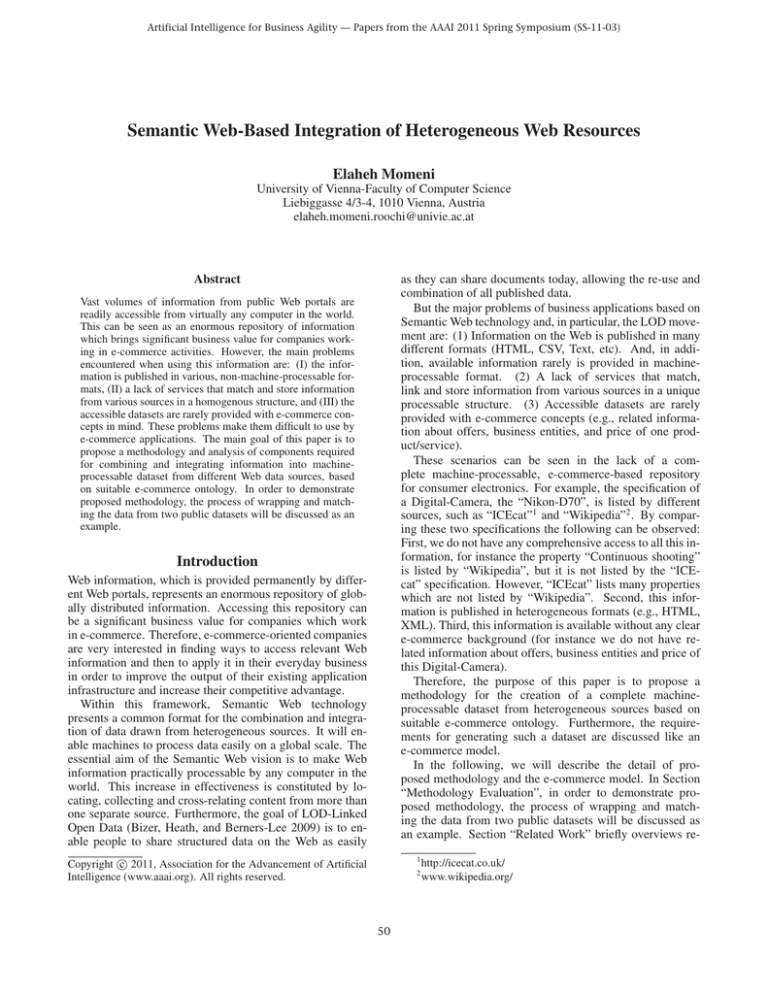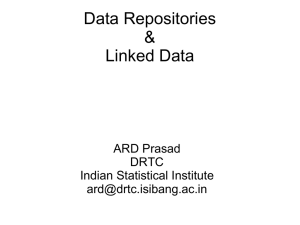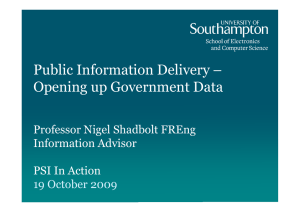
Artificial Intelligence for Business Agility — Papers from the AAAI 2011 Spring Symposium (SS-11-03)
Semantic Web-Based Integration of Heterogeneous Web Resources
Elaheh Momeni
University of Vienna-Faculty of Computer Science
Liebiggasse 4/3-4, 1010 Vienna, Austria
elaheh.momeni.roochi@univie.ac.at
as they can share documents today, allowing the re-use and
combination of all published data.
But the major problems of business applications based on
Semantic Web technology and, in particular, the LOD movement are: (1) Information on the Web is published in many
different formats (HTML, CSV, Text, etc). And, in addition, available information rarely is provided in machineprocessable format. (2) A lack of services that match,
link and store information from various sources in a unique
processable structure. (3) Accessible datasets are rarely
provided with e-commerce concepts (e.g., related information about offers, business entities, and price of one product/service).
These scenarios can be seen in the lack of a complete machine-processable, e-commerce-based repository
for consumer electronics. For example, the specification of
a Digital-Camera, the “Nikon-D70”, is listed by different
sources, such as “ICEcat”1 and “Wikipedia”2 . By comparing these two specifications the following can be observed:
First, we do not have any comprehensive access to all this information, for instance the property “Continuous shooting”
is listed by “Wikipedia”, but it is not listed by the “ICEcat” specification. However, “ICEcat” lists many properties
which are not listed by “Wikipedia”. Second, this information is published in heterogeneous formats (e.g., HTML,
XML). Third, this information is available without any clear
e-commerce background (for instance we do not have related information about offers, business entities and price of
this Digital-Camera).
Therefore, the purpose of this paper is to propose a
methodology for the creation of a complete machineprocessable dataset from heterogeneous sources based on
suitable e-commerce ontology. Furthermore, the requirements for generating such a dataset are discussed like an
e-commerce model.
In the following, we will describe the detail of proposed methodology and the e-commerce model. In Section
“Methodology Evaluation”, in order to demonstrate proposed methodology, the process of wrapping and matching the data from two public datasets will be discussed as
an example. Section “Related Work” briefly overviews re-
Abstract
Vast volumes of information from public Web portals are
readily accessible from virtually any computer in the world.
This can be seen as an enormous repository of information
which brings significant business value for companies working in e-commerce activities. However, the main problems
encountered when using this information are: (I) the information is published in various, non-machine-processable formats, (II) a lack of services that match and store information
from various sources in a homogenous structure, and (III) the
accessible datasets are rarely provided with e-commerce concepts in mind. These problems make them difficult to use by
e-commerce applications. The main goal of this paper is to
propose a methodology and analysis of components required
for combining and integrating information into machineprocessable dataset from different Web data sources, based
on suitable e-commerce ontology. In order to demonstrate
proposed methodology, the process of wrapping and matching the data from two public datasets will be discussed as an
example.
Introduction
Web information, which is provided permanently by different Web portals, represents an enormous repository of globally distributed information. Accessing this repository can
be a significant business value for companies which work
in e-commerce. Therefore, e-commerce-oriented companies
are very interested in finding ways to access relevant Web
information and then to apply it in their everyday business
in order to improve the output of their existing application
infrastructure and increase their competitive advantage.
Within this framework, Semantic Web technology
presents a common format for the combination and integration of data drawn from heterogeneous sources. It will enable machines to process data easily on a global scale. The
essential aim of the Semantic Web vision is to make Web
information practically processable by any computer in the
world. This increase in effectiveness is constituted by locating, collecting and cross-relating content from more than
one separate source. Furthermore, the goal of LOD-Linked
Open Data (Bizer, Heath, and Berners-Lee 2009) is to enable people to share structured data on the Web as easily
1
c 2011, Association for the Advancement of Artificial
Copyright Intelligence (www.aaai.org). All rights reserved.
2
50
http://icecat.co.uk/
www.wikipedia.org/
"250"
"EUR"
gr:hasCurrencyValue
Phase 1
Data Wrapping
gr:hasCurrency
"Price-1"
"C62"
"TypeAndQuant
ityNode-1"
gr:includesObject
"Offering-1"
WebLog
"Shop-1"
Web Source
2
.
.
.
"400"
gr:hasUnitOfMeasurment
gr:hasValue
corb:hasWeight
gr:offers
"QuantitaveV
alueFloat-1"
GoodRelation
class
Web Source
n
CORB Class
rdf:type
RDF Store1
Web Source
1
rdfs:SeeAlso
"Gr"
gr:typeOfGood
Wrapper
2
Loading
Engine
.
.
.
RDF Store2
Wrapper
n
RDF Store n
E-commerce
Model
Final RDF
Repository
CORB Methology
Individual
rdf:type
World Wide Web
subClassOf
GoodRelation
property
gr:ProductOr
Srvice
Matching
Engine
Wrapper
1
"http://Shop-Web-Address.com"
gr:hasPriceSpecification
rdf:type
corb:DigitalCa
mera
Phase 3
Data Loading
gr:Sell
gr:hasUnitOfMeasurment
"NikonD70"
Phase 3
Data Matching
gr:ActualProd
uctORService
Figure 2: Overview of the CORB Methodology
CORB Property
XSD
category’s ontology. Figure 1 shows and instantiated of the
model for Digital-Camera category. For the “DigitalCamera” category a subclass of “ProductOrService” (a class of
the GoodRelation ontology) is created. Furthermore, the
specific properties of each category (e.g., “hasWeight”) are
described comprehensively. Describing the properties comprehensively plays an important role in matching the properties from different sources.
Figure 1: An Instantiated of the E-commerce Model
lated work and finally, “Summary” Section concludes the
discussion and provides an outlook on possible area of future work.
Proposed Methodology and E-commerce
Model
Methodology
As we can see in Figure 2, CORB (Comprehensive Ontology-based Repository for Business-application)
methodology proposes the following phases for the creation
of such a comprehensive dataset:
With regard to the problems mentioned in the previous section, a methodology is required to define the workflow of a
machine-processable, e-commerce-based RDF dataset creation process and the necessary building blocks. However,
as a prerequisite to this process a model is required to introduce the necessary entities for the creation of such a dataset.
Data Wrapping: In the first phase, CORB proposes wrapping data from various sources into a RDF format. Each
wrapper has a different architecture and different components, according to its source. The main building blocks of
each wrapper are:
• An extract engine: this component is responsible for
searching for required data in a Web source, e.g., finding all the available data about a particular category of
product/service, and loading this data to a defined destination. The internal structure of this engine is completely
dependent on the structure of the Web data source. Many
Web portals offer easy access to their data via an API. In
other cases, this component can be selected from available
Web data extraction solutions, which are overviewed in
the “Related Works” Section. Furthermore, many available extract engines offer the extraction and loading of
data into the various formats.
• A transform engine: this engine, by using transformation language (e.g., XSLT), is responsible for: mapping
the Web Data Source Vocabulary to the specific extended
e-commerce model Vocabulary (e.g., if a property, such
as “hasWeight” for “DigitalCamera” category, is defined
in the specific extended e-commerce model, and “ICEcat” defines this property as “Weight” via user interface
E-commerce-based Model
To provide a comprehensive e-commerce-based RDF
dataset, an e-commerce ontology is required that allows the
properties of a specific category of product/service to be
described and the relationships between offerings made by
means of those products/services, legal entities, and prices
to be defined (Hepp 2005). For example, we must be able
to define that a particular Web site describes an offer to sell
a Digital-Camera of a certain model at a certain price, describing the specific properties of this Digital-Camera like
the quantity value of its Weight or Dimensions. Furthermore, by surveying the e-commerce based ontology related
work, GoodRelation ontology (Hepp 2008) is selected and
extended to model our required entities. GoodRelations is
defined as: “a lightweight yet sophisticated vocabulary that
allows manufacturers and shop operators to express the exact meaning of their offers made on the Web in a machineprocceasble way.” (Hepp 2008).
An individual ontology can be created for each different
product/service category based on the GoodRelation ontology. Therefore, each RDF instance is created based on its
51
Start
Start
Define the Format of the Web Data Source
Index All the Resources in Each Repository
Map the Web Data Source Vocabulary into E-commerce Model Vocabulary
of the Specific Category of Product/Service
Search for Each Resource of the First Repository in the Second
Repository Indexes
Extract for the Specific Category of Product/Service the List of Products/
Services
YES
There Is no
Resource
Select a Product/Service from the List
NO
YES
Create a Complete RDF Model of Properties from Both Repositories
End of the List
NO
Extract E-commerce and Specification Related Information from Web Data
Source
Load RDF Model into the Final RDF Store
Transform Extracted Related Information into RDF Model, Based on the
Category Specific E-commerce Model
Delete Match Resource in Second Repository
Search for Each Resource of the Second Repository in the First
Repository Indexes
Ingest RDF Model into the RDF Store
YES
END
There Is no
Resource
NO
Create a Complete RDF Model of Properties from Both Repositories
Figure 3: Internal Process of the Data Wrapping
Load RDF Model into the Final RDF Store
interaction, as a result the mapping between properties
descriptions is defined and saved in the transformation
script), changing the data format to RDF, and standardizing it (e.g., creates a valid triple according to “DigitalCamera” model with a valid URI).
END
Figure 4: Internal Process of the Data Matching
• An ingest engine: this engine loads all the created RDF
instances from one source into a single RDF repository.
uct/service the list of the relevant properties and e-commerce
entities (which are all available in the e-commerce model)
are gathered from the appropriate resources of each RDF
repository. Figure 4 shows the internal process of this phase.
Figure 3 shows the internal process of this phase. In
the case of wrapping information from HTML Web data
sources, using available solutions instead of specially designed wrappers is more effective. But in most cases these
tools wrap the data into XML or other formats, for which
further steps are needed to transform them into a standard
RDF format.
Data Loading: After finding the best matches, CORB
proposes that all created triples be loaded into a single RDF
repository in the third phase. Before loading the information, all the prepared information needs to be normalized
and standardized.
Data Matching: In the second phase, matching product/service resources from provided RDF-based repositories
of different sources (provided in the previous phase) and
completing the list of their properties and e-commerce relevant information is proposed. Therefore, product/service
resources in each repository are first indexed (e.g., by using Apache Lucene). Second, for each resource in the first
repository an index is searched for. The one to be selected
is the one with the highest match rank in the second repository (This is based on the assumption that either the highest
search rank is exactly the same product/service or there is
no match at all). In order to ensure improved accuracy in the
matching process between the product/service descriptions,
it is clear that the result of the selection process in indexes
needs to be carried out accurately in the index searching process. However, this issue is beyond the scope of this paper
and will be discussed in a later work. Finally, for each prod-
Methodology Evaluation
In order to demonstrate CORB methodology, we created an
RDF-based repository from 612 different Camcorder models from “ICEcat”3 (free open catalogue is available in
xml format) and “DBpedia”4 (structured information from
Wikipedia which is available in RDF format). We extended
GoodRelation ontology by defining the Camcorder category
specific properties. In the “Data Wrapping” phase: First, we
wrote a script to extract the information on each individual
camcorder from “ICEcat” as an XML format (e-commerce
and specification related information for each product). Sec3
4
52
http://icecat.co.uk//en/menu/services/index.htm
http://dbpedia.org/About
ond, we provided an XSLT transformation script which
mapped the Camcorder specification vocabulary of “ICEcat”
into our Camcorder model vocabularies and transformed the
information format into RDF format. Third, we ingested all
this converted data into an “ICEcat” RDF repository. Due
to the availability of “DBpedia” resources as RDF, we did
not run the wrapping process for this source. However, we
wrote a script, which mapped the Camcorder specification
vocabulary of “DBpedia” into our Camcorder model vocabulary.
In the “Data Matching” phase, we first, indexed all the
“DBpedia” resources which have “category:Camcorders” as
“skos:subject” property. Second, we listed all the products
of the “ICEcat” RDF repository and for each product in the
list searched for the match resource in the “DBpedia” indexes. Third, we built a triple for each product, each property in our camcorder model, and the value of the property
(which was found from one of two resources). In the “Data
Loading” phase we loaded all the created triples in a single
RDF repository.
Finally, in the final RDF repository we have: 612 comprehensive camcorder instances, which contain all the properties from both sources, 5527 shop instances (which are offering camcorder instances), 5527 offer instances, and 5527
price instances for each offer.
different Web sources in three phases: (1) Data Wrapping,
(2) Data Matching, and (3) Data Loading.
In order to provide this information with e-commerce
concepts in mind, we propose using an extension of
the GoodRelation ontology for each category of product/service, and to provide information from different Web
data sources in machine-processable format (e.g. RDF),
we propose implementing a specially designed wrapper
which wraps the data from different sources into a standard machine-processable format and maps the specification
of each product/service category to our category-related ecommerce ontology. And then, to match and store information from various sources in a single processable structure
(at the level of instance matching), we propose a matching
algorithm for finding information about a particular product from various available Web sources. This component
matches the missing properties of one product/service from
different Web sources to create comprehensive RDF instances.
As already noted, the future goal is to set up an experiment to find an appropriate approach for an accurate searching process for a product/service from a repository within
the indexes of another repository.
References
Baumgartner, R.; Frölich, O.; and Gottlob, G. 2007. The
lixto systems applications in business intelligence and semantic web. In Proceedings of the 4th European conference
on The Semantic Web: Research and Applications, ESWC
’07, 16–26. Berlin, Heidelberg: Springer-Verlag.
Bernstein, P. A., and Haas, L. M. 2008. Information integration in the enterprise. Commun. ACM 51(9):72–79.
Bizer, C.; Volz, J.; Kobilarov, G.; and Gaedke, M. 2009.
Silk - a link discovery framework for the web of data. In
18th International World Wide Web Conference.
Bizer, C.; Heath, T.; and Berners-Lee, T. 2009. Linked data
- the story so far. International Journal on Semantic Web
and Information Systems 5(3):1–22.
Haslhofer, B., and Klas, W. 2010. A survey of techniques
for achieving metadata interoperability. volume 42, 1–37.
New York, NY, USA: ACM.
Hepp, M. 2005. A methodology for deriving owl ontologies from products and services categorization standards. In
ECIS.
Hepp, M. 2008. Goodrelations: An ontology for describing
products and services offers on the web. In Gangemi, A.,
and Euzenat, J., eds., EKAW, volume 5268 of Lecture Notes
in Computer Science, 329–346. Springer.
Related Work
Matching and mapping Web data hava a long research history. Volz et al. (Bizer et al. 2009), for instance, proposed
a tool (Silk-A Link Discovery Framework for the Web of
Data) for finding relationships between entities within different data sources. The Silk can be used by data publishers
to establish RDF links from their data sources to other data
sources on the Web. Haslhofer and Klas. (Haslhofer and
Klas 2010) provide a comprehensive study on techniques for
metadata mapping. Furthermore, we can name researches
such as (Bernstein and Haas 2008).
Early related work on the issue of Web data extraction can
be traced back to tools such as: Lixto (Baumgartner, Frölich,
and Gottlob 2007) is a visual and interactive wrapper generator which uses an expressive and exible logic-based declarative language. Deep Web Makro Recording/Replaying allows for deep Web navigation ability and it is also able to
pars Java Script and has additional offset-based data extraction. Kapow Technologies5 which enables the conversion of
disparate streams of Web data into strategic business assets.
Sundewsoft6 is an Eclipse-based wrapper generator using Internet Explorer, Web macro recording, and data patterns. It
exports to XML, CSV or Excel.
Summary
In this paper, we have presented CORB methodology
which attempts to satisfy three main requirements when ecommerce-based applications use vast amounts of information from different public Web portals. It recommends creating a comprehensive e-commerce RDF-based dataset from
5
6
http://kapowtech.com
http://www.sundewsoft.com
53






